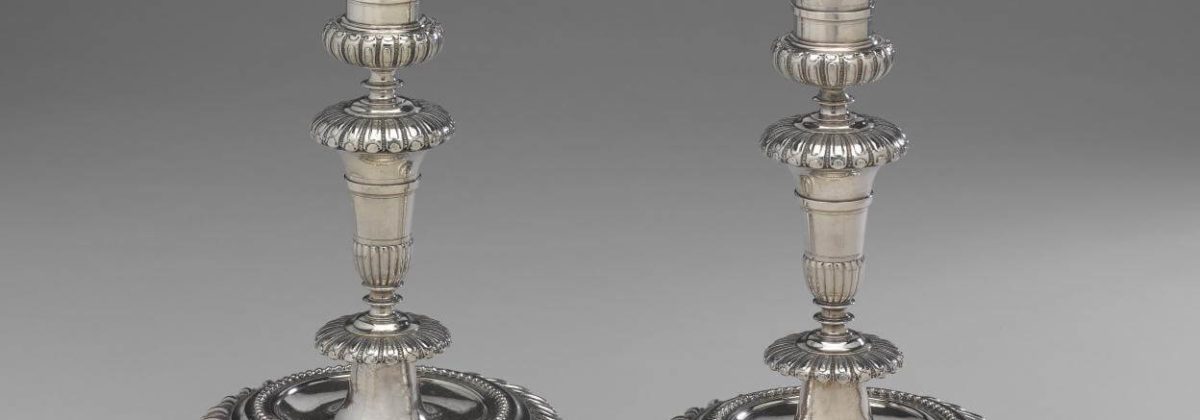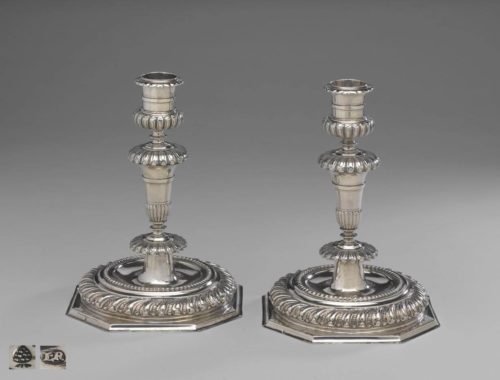Object Number: #715
Augsburg, ca. 1705
Maker: Georg III Lotter
City’s hallmarks: The Pyr for Augsburg, Period 1705-1709 (s. Seling, 2007, no. 1310, vol. III/46)
Maker’s mark: the monogram „L•R“ in a shield for Georg III Lotter (s. Seling, 2007, no. 1834, vol. III/405)
Dimensions: Height: 22,5 cm (8,7 in.); Weight: c. 530 gr each
Detailed Information
A Fine Pair of German Silver Candlesticks
The present pair of standing candlesticks represents an early type of candlesticks of the Regency and the Rococo style of 18th century. The decoration is through clear and elegant forms shaped and is towards French models oriented. The candlesticks are standing on a broad, vaulted and moulded foot, which is on its turn in a step-wise manner decorated. The foot is prominent with octagonal edges that shape a border, a feature of candlesticks of the early 18th century and, in particular, of the Regency style (see for an example Seling 1980, II/fig. 813). The main decorative motive of the foot is an artistic, well-executed lamb’s tongue frieze and a running pearls ring in the interior side of the foot. A shaft with baluster and gadrooned decorative elements rises above the foot, while it is narrowing on its base. The overall shape of the shaft is characterised through profiled nodes with lamb’s tongue decoration. The edge of the baluster-shaped, broad spout is through a pearl-ring circumscribed and distinguished. The choice to create superimposed zones of fine, alternate decorative motifs, rings and necking emphasises the excellent executed work as well as the quality of the used template.
Candles were in general in former times a very important light-source. The difference between church and profane candlesticks is mostly the existence in the first type of candlesticks of a thorn in order to pin the candle as well as their larger height. Profane candlesticks on the other hand hat a spout, where the candle was pushed in. This pair of candlesticks from the maker Georg III Lotter belongs to an exceptional work – in quality and execution – from Augsburg of around 1700. There are only a few examples of this period preserved.
It was a clear sign of wealth, when the aristocratic society was in the position to organise parties, diners and soirees under the warm candlelight diffused from shiny and artful candlesticks. In order to accentuate the luxury of these wares, there were various types of candlesticks for very different purposes produced.
The goldsmith’s town Augsburg, in Germany, has produced many different types of candlesticks. Moreover the execution of these works was masterful and the shape of them had always been faithful to the contemporary mode and styles.
Decors of the kind that the present candlesticks exhibit were at first in France of the end of the 17th century produced. Since 1700 the patterns were in Augsburg common and standardised and candlesticks from this town adorned multi-piece table sets and table decorations. Changes in style were defined from France – from the French court in Versailles and from Paris. Baluster motifs, like the ones the present pair of candlesticks present, were a favourite decoration in the French tableware of this time-period.
Maker
The silversmith Georg III Lotter was the son of Georg II, born in 1658 in a protestant family. He became a master around 1688. He was first married in 1688, to Sabine Küsel (daughter of the goldsmith Philipp Küsel), and for a second time in 1690. He died in 1714. His workshop continued to be active after his death until around 1717, taken over by his widow. This was under certain conditions and rules possible, one needed though an express permission.
Literature
Gruber, Al., 1982, Gebrauchssilber des 16. bis 19. Jahrhunderts, transl. by Ur. Reinhardt and G. Meister, Würzburg: Edition Popp
Kommer, Bj. R., 2002, ‚Silber aus Augsburg: Die Kollektion im Augsburger Maximilianmuseum. Bemerkungen zur Entwicklung im 18. Jahrhundert’ in Weltkunst, 2002, Nr. 72, S. 2034-39
Seling, H., 1980, Die Kunst der Augsburger Goldschmiede 1529-1868, Bd. I-III, München: Beck Verlag



